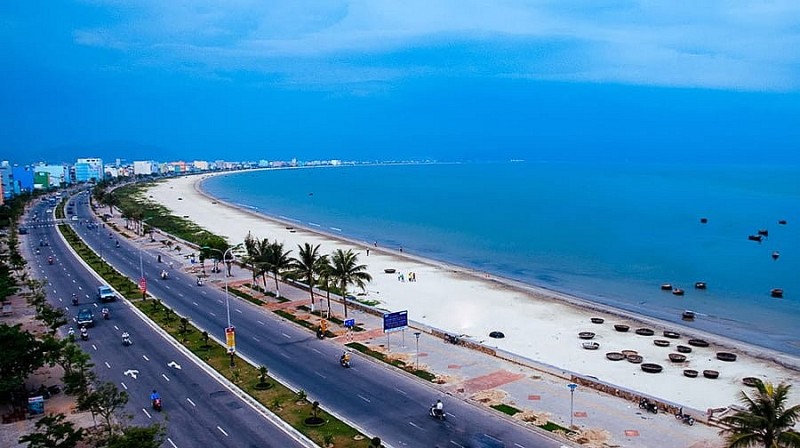Master plan for sustainable exploitation and use of coastal resources in 2021-2030 period, to 2050
(BNP) - Deputy Prime Minister Tran Hong Ha has just signed Decision No. 1117/QD-TTg dated October 7, 2024 approving the master plan for sustainable exploitation and use of coastal resources in the 2021-2023 period, with a vision to 2050.

Illustrative photo (source: Internet).
The general objective of the Plan to 2030 is to manage, exploit, and effectively use coastal resources, contributing to making Vietnam a strong maritime nation, rich from the sea, with sustainable development, prosperity, security, and safety, ensuring livelihoods and improving the living standards of coastal communities, associated with the conservation and development of natural, ecological, and cultural values; actively prevent natural disasters; effectively respond to climate change and rising sea levels; and strictly control and prevent trends of pollution and environmental degradation and coastal ecosystems.
The specific objectives are to protect, maintain, and restore ecosystems, biodiversity, and other values of coastal areas; increase the conservation area; protect natural values, marine ecology, and mangrove forests in coastal areas, contributing to the goal of achieving a minimum area of 6% of the natural area of the national sea.
Arrange and reasonably allocate space for sectors and fields and fundamentally resolve overlaps and conflicts in the exploitation and use of coastal resources, ensure the resilience of ecosystems, and protect the coastal environment, contributing to achieving the following targets: 100% of hazardous waste, domestic solid waste, and 100% of plastic waste at beaches, coastal tourist areas, and marine reserves are collected and treated; 100% of economic zones, industrial zones, and coastal urban areas are planned and built in a sustainable, ecological, smart, and safe direction, with centralized wastewater treatment systems that meet environmental standards and regulations.
Ensuring people's access to the sea, improving livelihoods and raising living standards for coastal communities, eliminating particularly disadvantaged communes in coastal areas, contributing to increasing the average income per capita of coastal provinces and cities by 1.2 times or more compared to the average income of the whole country, protecting and preserving cultural heritages, promoting historical traditions, maritime cultural identity, contributing to building and developing a comprehensive Vietnamese human culture, in line with the trend of the times...
Vision to 2050, coastal resources are managed and exploited, used effectively and sustainably to comprehensively develop marine economic sectors, contributing to making coastal areas a vibrant economic - cultural development center, attracting investment, a gateway connecting development space between the mainland and the sea, connecting trade between Vietnam and the world; build coastal areas into a solid foundation to advance to the sea and create momentum for other regions in the country to develop together; have a clean, safe environment and natural, ecological, landscape, cultural and historical values are protected, preserved and developed; firmly ensure national defense and security, aiming to make our country a strong maritime nation, rich from the sea, with sustainable development, prosperity, security and safety, achieving zero net emissions by 2050.
The scope of coastal planning includes coastal waters and coastal land, specifically: coastal waters have an inner boundary that is the average lowest waterline over many years (18.6 years) and an outer boundary that is 6 nautical miles from the average lowest waterline over many years. Coastal land includes coastal communes, wards, and towns in 28 coastal provinces and centrally run cities.
However, to ensure the integrity of important ecosystems and habitats and to fully pay attention to the strong interaction between land and sea, the coastal spatial scope in some areas is expanded to both the land and sea.
The decision proposes six solutions for implementing the planning, including: management solutions; solutions on environment, science, and technology; solutions on propaganda and raising awareness; solutions on training and capacity building; solutions on investment finance; and solutions on international cooperation.
The Prime Minister assigned the Ministry of Natural Resources and Environment to preside over and coordinate with ministries, ministerial-level agencies, People's Committees of coastal provinces, and centrally run cities to organize and inspect the implementation of planning; periodically organize assessment, review, and adjustment of planning according to regulations; and announce planning according to the provisions of the Law on Planning.
At the same time, build and manage a database system for planning implementation; provide planning information to the information system and national database on planning according to regulations. Coordinate with the Ministry of Finance and the Ministry of Planning and Investment to arrange annual budgets; synthesize and submit to competent authorities to assign medium-term and annual public investment plans to implement planning.






